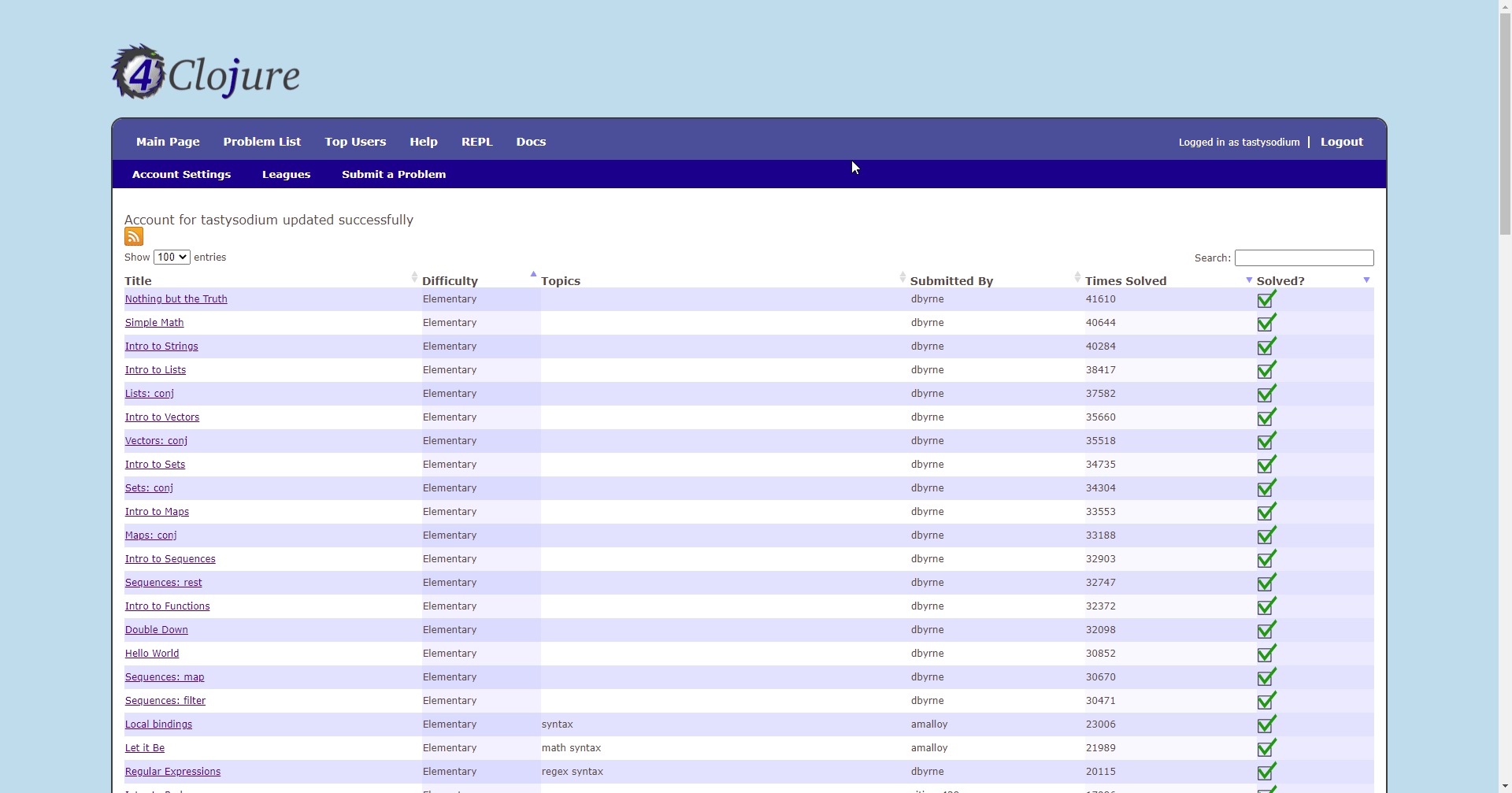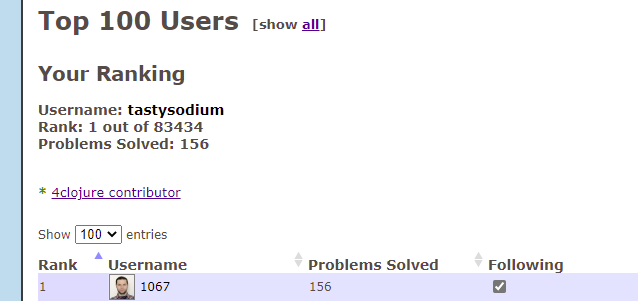on
What I learned solving all 156 4Clojure problems

I solved them all. Here’s the jist of what I’ve learned:
- Psycho-Cybernetics works
- Diffused state for creative shit
- Can meditate into it
- Read Mortimer Adler style
- TDD’s useful
Psycho-Cybernetics works
I knew about Psycho-Cybernetics going through this, but it hit home for me when I spun my wheels on a big problem (I forget which). I took a break and read, Mortimer Adler style, all of Psycho-Cybernetics. I did as Adler suggested and outlined the whole book, and I came to understand it as this: If your body were a “gun”, what it points at is your goal, your physical health is the “bullets”, and feeling strongly squeezes the trigger. Some goals are hunted with a single shot. Most goals are big and take many (hundreds of) bullets to bring home the game. I think the reason I succeeded in solving all 156 4Clojure problems is because I used this and pointed at the target and “squeezed the trigger” hundreds of times until I brought it down. That is: I kept the goal in mind and felt strongly about it for a period of two and a half months until I solved them all. Psycho-Cybernetics works.
Get creative with the diffused state
There were many problems that would’ve overwhelmed me if I didn’t: 1) believe in Psycho-Cybernetics, and 2) understand the diffused state where new “ahas” are found. I talked about #1. For #2, Isaac Asimov (1971) wrote about this with the “The Eureka Phenomena” detailing this state with five examples spanning over two thousand years, from the time of Archimedes with the crown problem in Syracuse circa 250 B.C. to himself solving a key problem in his dissertation circa 1960. Barbara Oakley shows how Edison’d relax with ball bearings in his hand. When he’d nearly fall asleep, it’d drop and wake him up, and he’d apply the insights from the diffused state to his problems. Dr. Kanojia of recent fame, a Harvard-trained psychiatrist who’s worked with many famous personalities like Pokimane, Asmongold, Reckful, says about studying, “The first thing to understand about studying is the more calm or tranquil your mind, the more receptive it is to information”. I don’t have detailed records of my “diffused state” experiences, but I can tell you generally that’s the state that gave me the “aha” needed to solve hard problems.
Meditate into the diffused state
Because I viewed Dr. K’s meditation videos, I understood meditation’s ability to put me in the diffused state, so I did it consistently while solving these problems. I opted for the “doing meditation”, and I went on to use it with much success. That is, I’d set a two minute timer every time I needed a break or a “creativity” spurt and just zone in on a single point in my room, letting it crowd out thoughts of the problem and everything else. Not only did this relax my mind and body, but I came back with strength and many, many times I got an aha and I solved it. Without this technique, I don’t think I would’ve solved the problems–soon or ever.
Read Mortimer Adler style
On the journey to solving the 4Clojure problems, you’ll need to read about K-maps, minterms, Gray code, binary relations, bijections, set theory, and more. It’s possible you’re educated in these concepts, but if you aren’t you’ll need read and understand them. Nothing’s helped me with reading comprehension like Mortimer Adler’s book, How to Read a Book. There’s some tedious processes in there that may strike you as dumb, but they really, really work. For instance, a K-map is a truth table squeezed into a different kind of table where the axis are incremented with Gray code, which looks like binary digits but differs in that one digit changes at a time to get to the next digit (which doesn’t happen in traditional binary). This allows you to plot things on a map, make base-2 groups of cells with 1’s in it, find what doesn’t change, and boom, these groups give you a minimized equivalent Boolean function that would otherwise take eight or sixteen or so minterms/maxterms. Doesn’t make sense yet? Use Mortimer’s approach to learn these materials, and you’ll figure it out.
TDD saves ~ 75% of the time
I’m not alone in saying this. Don Wells writes about the Chrysler Comprehensive Compensation program’s switch to Extreme Programming (i.e. using a lot of unit tests): “Don has some rough estimate and believes the team was going six and a half times faster than before [using unit tests]”. He writes about his second experience with Ford’s Vehicle Cost and Profitability System (VCAPS), “As production bugs dropped even further the team became more productive eventually reaching a factor of ten times”. So I don’t think it’s extreme (well it is an extreme programming practice) to say that when I started TDD about 120 problems in, at more granular levels than what the 4Clojure test cases offered, that I reduced my time-to-solution to 25% of what it was, saving 75% of my time and energy.
Clojure secrets
Yes, I’ve learned a LOT about the Clojure language, hidden functions (letfn, reify) and features (macros, loop-recur, reduce), and neat surprises (peek, rseq, droplast are hundreds of times faster operations for vectors than last, reverse, and butlast), and gotchas (a vector is not a seq! Use coll? or vector? to detect it). My competence with recursion–and the assisting recursive function reduce–has shot through the roof. I’ve improved my ability to manipulate data (assoc, assoc-in, update, update-in, dissoc) and get data (nth, get, get-in). I suppose these are simple, but it’s nice when it becomes second nature to wield data around–and to know that these don’t apply to lists (exc. nth) but vectors and maps. I’ve learned about the ways of Clojure’s strange implementation of for (it could easily be called cartesian-product). I’ve picked up many goodies like partition-by, interleave, interpose, repeat.
TDD’s the big aha
I expected to take a month for these problems, but it took two and a half months. I spent so much time spinning my wheels, trying to cram four functions into one. When there was a tiny chance of it working, I’d run it through the test case hoping it’d work, and feeling dejected when it didn’t. Knowing TDD would’ve prevented that, and I would’ve solved it faster with more certainty. If I had to wipe my brain of all Clojure knowledge and restart this challenge, but with a TDD approach, I think that I could do it in a month.
